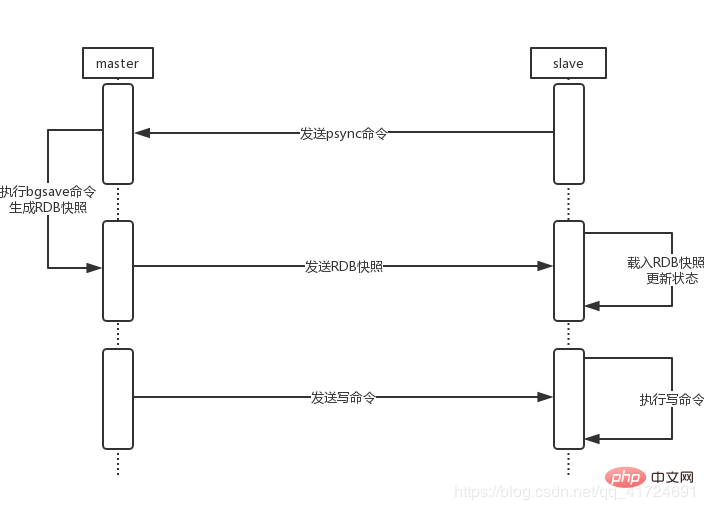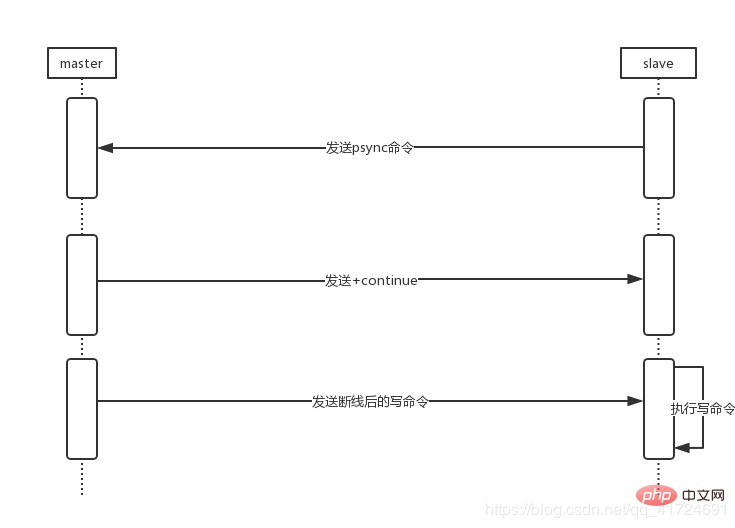Redis master-slave synchronization principle

1. Foreword
In order to ensure the high availability of redis, a cluster mode is generally built, which is the master-slave mode.
The master-slave mode can ensure the high availability of redis, so how does redis ensure the data consistency of the master-slave server? Next, let's briefly talk about the principle of redis master (master) and slave (slave) synchronization.
2. Initial full synchronization
#When a redis server sends the salveof command to the master server for the first time, the redis slave server will perform a full synchronization , the synchronization steps are shown in the figure below:

- The slave server sends the psync command to the master (the psync command sent at this time is psync ? -1 ), tell the master that I need to synchronize data.
- After receiving the psync command, the master will execute the BGSAVE command to generate a snapshot of the RDB file.
- After the generation is completed, the RDB file will be sent to the slave.
- After the slave receives the file, it will load the RDB snapshot and change the database status to be consistent with the status of the master when executing BGSAVE.
- The master will send all the write commands saved in the buffer to tell the slave that it can be synchronized.
- The slave executes these write commands.
3. Command propagation
The slave has synchronized with the master, then if the subsequent master For a write operation, such as a simple set name redis, after the master executes the current command, it will send the current command to the slave for execution to achieve data consistency.
4. Re-copy
When the slave is disconnected and reconnected, it will be resynchronized. The resynchronization is divided into full synchronization and partial synchronization
First let’s take a look at the general trend of partial synchronization

In fact, after the slave sends the psync command to the master, the master still needs to judge whether to perform partial synchronization based on the following three points. Let’s first introduce the three aspects:
- ##When the slave disconnects and reconnects, the psync command will be sent to master.
- The master will return a continue reply after receiving psync, indicating that the slave can perform partial synchronization.
- master sends the write command after disconnection to slave
- slave executes the write command.
- Server running ID
Every After a redis server is started, a running ID will be generated.
When performing the initial synchronization, the master will tell the slave its ID, and the slave will record it. When the slave is disconnected and reconnected, it will try to perform the synchronization if it finds that the ID belongs to this master. Partial resync. A complete resynchronization will be performed when the ID is different from the currently connected master.
- Replication offset
Replication offset includes master replication offset When the replication offset of the two databases is the same after the initial synchronization, then the master executes a write command, then the offset of the master is 1, the master will write the command to the slave, the slave executes it once, and the slave offset Measure 1 so that the versions will be consistent.
- Replication backlog buffer
The replication backlog buffer is fixed and maintained by the master A first-in-first-out queue of length.
When the slave sends psync, it will also send its own offset to the master. When the data after the slave's offset still exists in the buffer, it will return continue to notify the slave. Perform a partial resynchronization.
When the data after the slave offset is no longer in the buffer, a complete resynchronization will be performed.
Combining the above three points, we can summarize:
- When the slave disconnects and reconnects, it will send the psync command to the master.
- The master will first judge the server running id. If it is the same as its own, it will judge the offset.
- The master will judge its own bias. Whether the shift amount is consistent with the offset of the slave.
- If it is inconsistent, the master will go to the buffer to determine whether the data after the slave's offset exists.
- If it exists, a continue reply will be returned, indicating that the slave can perform partial synchronization.
- master sends the write command after disconnection to slave
- slave executes the write command.
5. The final process of master-slave synchronization

6. Conclusion
Recently, when the company needed it, I built a redis master-slave cluster and used sentinels to monitor and implement master-slave switching. Therefore, I sorted out the master-slave principle of redis based on "Redis Design and Implementation" to deepen my impression.
## Recommended tutorial: "redis tutorial"
The above is the detailed content of Redis master-slave synchronization principle. For more information, please follow other related articles on the PHP Chinese website!

Hot AI Tools

Undresser.AI Undress
AI-powered app for creating realistic nude photos

AI Clothes Remover
Online AI tool for removing clothes from photos.

Undress AI Tool
Undress images for free

Clothoff.io
AI clothes remover

AI Hentai Generator
Generate AI Hentai for free.

Hot Article

Hot Tools

Notepad++7.3.1
Easy-to-use and free code editor

SublimeText3 Chinese version
Chinese version, very easy to use

Zend Studio 13.0.1
Powerful PHP integrated development environment

Dreamweaver CS6
Visual web development tools

SublimeText3 Mac version
God-level code editing software (SublimeText3)

Hot Topics
 How do I choose a shard key in Redis Cluster?
Mar 17, 2025 pm 06:55 PM
How do I choose a shard key in Redis Cluster?
Mar 17, 2025 pm 06:55 PM
The article discusses choosing shard keys in Redis Cluster, emphasizing their impact on performance, scalability, and data distribution. Key issues include ensuring even data distribution, aligning with access patterns, and avoiding common mistakes l
 How do I implement authentication and authorization in Redis?
Mar 17, 2025 pm 06:57 PM
How do I implement authentication and authorization in Redis?
Mar 17, 2025 pm 06:57 PM
The article discusses implementing authentication and authorization in Redis, focusing on enabling authentication, using ACLs, and best practices for securing Redis. It also covers managing user permissions and tools to enhance Redis security.
 How do I implement cache invalidation strategies in Redis?
Mar 17, 2025 pm 06:46 PM
How do I implement cache invalidation strategies in Redis?
Mar 17, 2025 pm 06:46 PM
The article discusses strategies for implementing and managing cache invalidation in Redis, including time-based expiration, event-driven methods, and versioning. It also covers best practices for cache expiration and tools for monitoring and automat
 How do I use Redis for job queues and background processing?
Mar 17, 2025 pm 06:51 PM
How do I use Redis for job queues and background processing?
Mar 17, 2025 pm 06:51 PM
The article discusses using Redis for job queues and background processing, detailing setup, job definition, and execution. It covers best practices like atomic operations and job prioritization, and explains how Redis enhances processing efficiency.
 How do I use Redis for pub/sub messaging?
Mar 17, 2025 pm 06:48 PM
How do I use Redis for pub/sub messaging?
Mar 17, 2025 pm 06:48 PM
The article explains how to use Redis for pub/sub messaging, covering setup, best practices, ensuring message reliability, and monitoring performance.
 How do I monitor the performance of a Redis Cluster?
Mar 17, 2025 pm 06:56 PM
How do I monitor the performance of a Redis Cluster?
Mar 17, 2025 pm 06:56 PM
Article discusses monitoring Redis Cluster performance and health using tools like Redis CLI, Redis Insight, and third-party solutions like Datadog and Prometheus.
 How do I use Redis for session management in web applications?
Mar 17, 2025 pm 06:47 PM
How do I use Redis for session management in web applications?
Mar 17, 2025 pm 06:47 PM
The article discusses using Redis for session management in web applications, detailing setup, benefits like scalability and performance, and security measures.
 How do I secure Redis against common vulnerabilities?
Mar 17, 2025 pm 06:57 PM
How do I secure Redis against common vulnerabilities?
Mar 17, 2025 pm 06:57 PM
Article discusses securing Redis against vulnerabilities, focusing on strong passwords, network binding, command disabling, authentication, encryption, updates, and monitoring.






